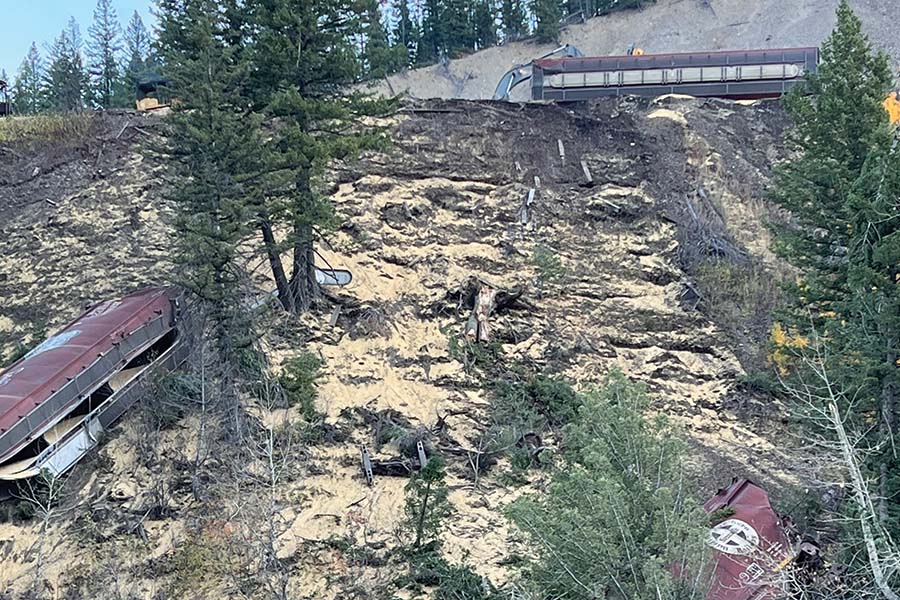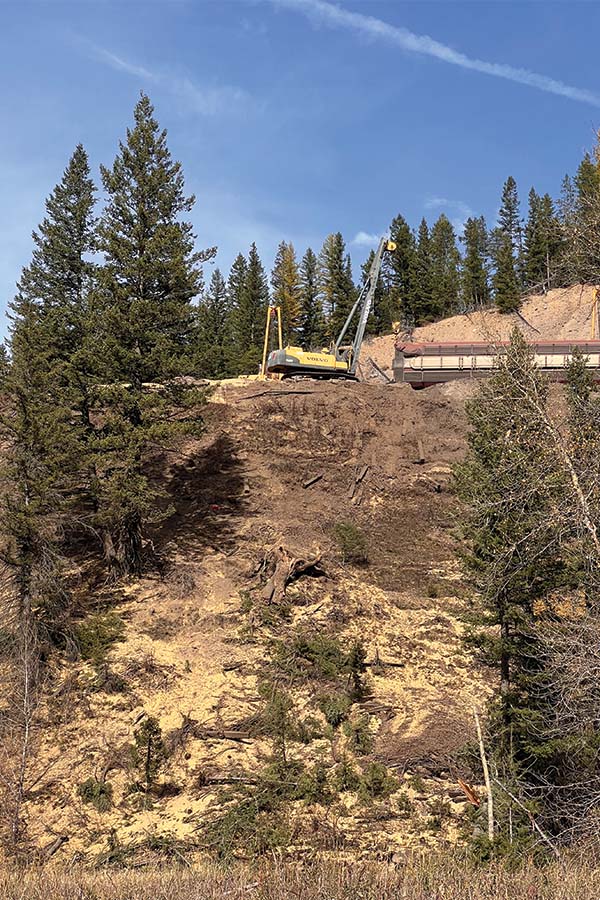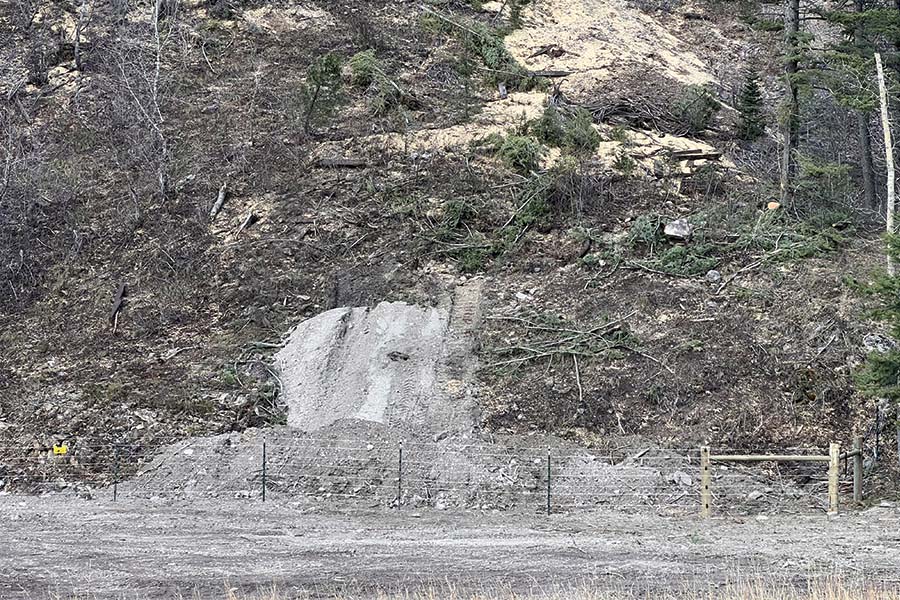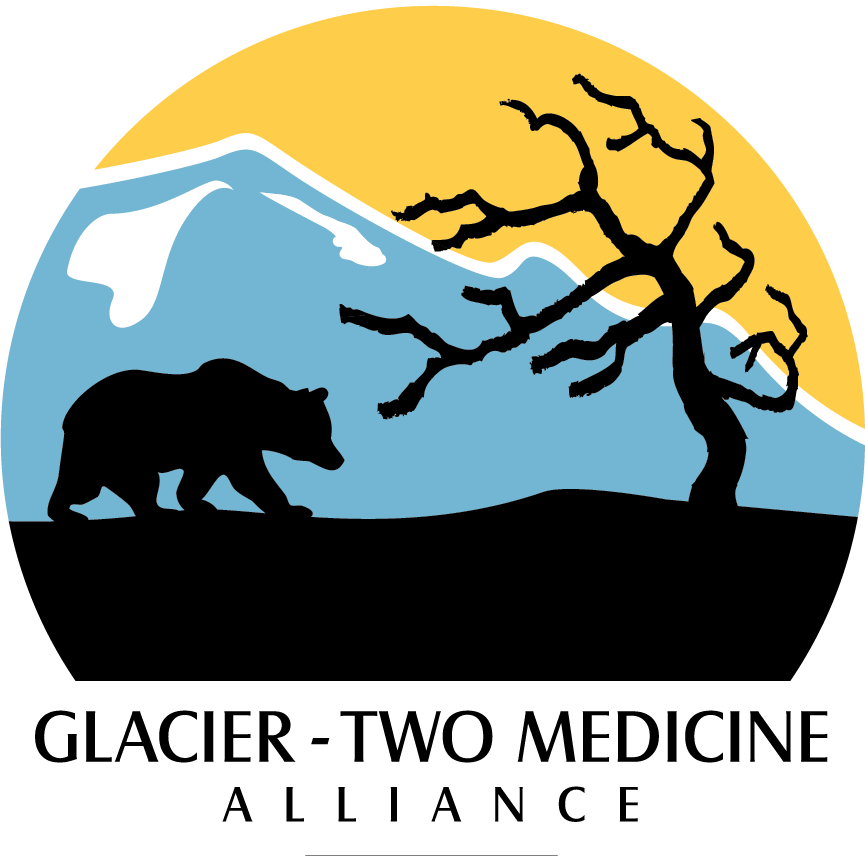
By Peter Metcalf
Executive Director

BNSF Grain Spill Cleanup Complete
Risk to Grizzly Bears and other Wildlife Remains
The cleanup of a major grain spill on the southern edge of Glacier National Park has been completed, according to the BNSF railway and federal officials familiar with the situation. The spill occurred on October 13th when a westbound BNSF Railway grain train derailed, spilling hundreds of tons of soybeans down a steep embankment above the highway across from the Bear Creek river access site about four miles east of Essex. Twelve cars left the tracks, with two coming to rest close to US 2. No one was hurt. The cause remains under investigation.
BNSF has removed the derailed cars, repaired the tracks, and sucked up most of the soybeans from the site using vacuum trucks. However, some concentrations of soybeans remain scattered on the hillside plainly visible from the highway as well as in the railway right-of-way. The remaining grain may attract grizzly bears, especially once it starts to ferment in the spring. Grizzly bears or other wildlife may be hit and killed attempting to cross the highway to reach it or when foraging along the railway.

To reduce the risks, BNSF installed a high tensile electric fence around the spill along with game cameras to monitor for bear presence. Motion sensor deterrents were placed near residual grain on the right-of-way where fencing was not possible. Large warning signs alert travelers to be alert for wildlife crossing the highway.

The Flathead National Forest’s Hungry Horse Ranger District, which manages the land where the spill occurred, has asked anyone who sees a grizzly bear in the vicinity to please report it to their office at 406-387-7800.
Grain spills by the BNSF Railway have been a major obstacle to grizzly bear recovery for decades. The issue first rose to public prominence following several high-profile grain train derailments in the 1980’s and ‘90s which contributed directly to the deaths of numerous grizzly bears when they were hit foraging on the fermented grain. Even absent major spills, grain trains still pose a particular risk to grizzly bears as they often leak grain as they travel; this energy-dense food can attract grizzly bears to forage along the right-of-way, where they may be hit and killed. Many of the bears killed by trains over the years along the southern edge of Glacier have had grain in their stomachs according to scientific reports.
Beginning in the 1990s,the BNSF Railway undertook a number of operational changes, including introduction of less leaky grain cars, to reduce the risks trains pose to grizzly bears as well as to avoid potential financial penalties for killing grizzly bears. It is illegal under the Endangered Species Act to kill a grizzly bear without a permit even as part of routine railroad operations (except in the defense of life). Notably, BNSF still does not have an incidental take permit to kill grizzly bears because it has never completed the required Habitat Conservation Plan. The latest version, which was submitted nearly a year ago after renewed public pressure by GTMA and others, still has not won approval from US Fish and Wildlife Service, Montana Fish, Wildlife and Parks, or Blackfeet Nation because the Railway still does not commit enough to minimize or mitigate grizzly bear deaths.
While BNSF’s investments in infrastructure and technology appear to have reduced major grain spills (the last one occurred around 2014), as well as routine leakage according to various reports, this most recent derailment serves as yet another reminder that trains continue to pose a significant risk to grizzly bears. Since 2004, at least 27 grizzly bears are known to have been killed by trains on BNSF’s tracks between East Glacier and Columbia Falls, including three last year and at least one so far this year. Train strikes account for an estimated 9% of all human-caused deaths in the Crown of the Continent ecosystem, according to a 2019 report by biologist David Mattson.
In addition to killing bears, the railroad, along with the adjacent highway, impedes bears’ ability to move across the landscape, movements essential both to survival of individuals and the sustained recovery of viable populations both in the Crown and across the northern Rockies.
While GTMA appreciates the BNSF Railway’s impressive rapid response to this incident, the railroad can and should do more to minimize and mitigate the cumulative impacts it has on grizzly bears and other wildlife. One thing BNSF could do immediately is to make substantive commitments as part of its proposed Habitat Conservation Plan to take specific actions or to provide meaningful funding for projects that promote safe wildlife movement across its tracks or the highway. This would not only effectively reduce mortality while improving connectivity, it would demonstrate BNSF’s stated commitment to being a good neighbor and environmental steward.
Meanwhile, all of us who drive US 2 need to also do our part to prevent grizzly bears from dying as a result of BNSF’s latest grain spill. Please remember to slow down and report grizzly or black bear sightings to the Flathead National Forest’s Hungry Horse Ranger District.

Want to do more?
Report wildlife observations along US 2 between Columbia Falls and Browning with our easy-to use smart phone app. This data will inform future mitigation planning and projects, like where to site wildlife crossings.
